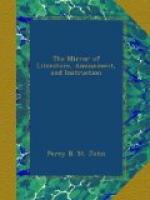Two Years in Ava.
* * * * *
MISCELLANIES.
* * * * *
SONNET.
ON A YOUTH WHO DIED OF EXCESSIVE FRUIT-PIE.
Currants have check’d the current
of my blood,
And berries brought me to
be buried here;
Pears have pared off my body’s hardihood,
And plums and plumbers spare
not one so spare.
Fain would I feign my fall, so fair a
fare
Lessens not hate, yet ’tis
a lesson good:
Gilt will not long hide guilt; such thin
wash’d ware
Wears quickly, and its rude
touch soon is rued.
Grave on my grave some sentence grave
and terse,
That lies not as it lies upon
my clay,
But, in a gentle strain of unstrained
verse,
Prays all to pity a poor patty’s
prey—
Rehearses I was fruitful to my hearse,
Tell that my days are told,
and soon I’m toll’d away!
THE VEIL OF MARY QUEEN OF SCOTS.
Maria Stuart has been canonized, and placed among the martyrs by the Jesuits. Of course there are relics of hers. Her prayer-book was long shown in France; and her apologist published in an English journal a sonnet which she was said to have composed, and to have written with her own hand in this book. A celebrated German actress, Mrs. Hendel-Schutz, who excited admiration by her attitudes, and also performed Schiller’s “Maria” with great applause in several cities of Germany, affirmed that a cross which she wore on her neck was the very same that once belonged to the unfortunate queen. Relics of this description have never yet been subjected to the proof of their authenticity. But if there is anything which may be reasonably believed to have been once the property of the queen, it is the veil with which she covered her head on the scaffold, after the executioner, whether from awkwardness or confusion is uncertain, had wounded the unfortunate victim in the shoulder by a false blow. This veil still exists, and is in the possession of Sir J.C. Hippisley, who claims to be descended from the Stuart’s by the mother’s side. He had an engraving made from it by Matteo Diottavi, in Rome, 1818, and gave copies to his friends.
The veil is embroidered with gold spangles by (as is said) the queen’s own hand, in regular rows crossing each other, so as to form small squares, and edged with a gold border, to which another border has been subsequently joined, in which the following words are embroidered in letters of gold:—




